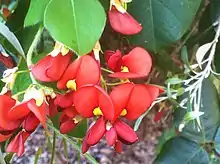Kennedia lateritia
Kennedia lateritia, commonly known as Augusta kennedia,[2] is a species of flowering plant in the family Fabaceae and is endemic to the south-west of Western Australia. It is a woody climber with twining stems, trifoliate leaves and orange-red and yellow flowers arranged in groups of up to twenty-four.
| Kennedia lateritia | |
|---|---|
 | |
| Scientific classification | |
| Kingdom: | Plantae |
| Clade: | Tracheophytes |
| Clade: | Angiosperms |
| Clade: | Eudicots |
| Clade: | Rosids |
| Order: | Fabales |
| Family: | Fabaceae |
| Subfamily: | Faboideae |
| Genus: | Kennedia |
| Species: | K. lateritia |
| Binomial name | |
| Kennedia lateritia | |
| Synonyms[1] | |
| |
Description
Kennedia lateritia is a woody climber with twining stems that cover low vegetation or sometimes climb trees to a height of up to 4 m (13 ft). Its leaves are trifoliate with elliptic, round or broadly egg-shaped leaflets 50–85 mm (2.0–3.3 in) long and 35–75 mm (1.4–3.0 in) wide, each leaf on a petiole 30–50 mm (1.2–2.0 in) long and the end leaflet on petiolule up to about 8 mm (0.31 in) long. There are stipules 15–20 mm (0.59–0.79 in) long at the base of the petiole. The flowers are arranged in up to eight clusters of three along a peduncle up to 100 mm (3.9 in) long, each flower on a pedicel about 8 mm (0.31 in) long. The five sepals are 6–7 mm (0.24–0.28 in) long and the petals are 15–18 mm (0.59–0.71 in) long. The standard petal is brick red with a yellow base and the wings are about the same length as the keel. Flowering occurs from October to November and the fruit is a cylindrical pod 40–50 mm (1.6–2.0 in) long and 6–10 mm (0.24–0.39 in) wide.[2][3][4]
Taxonomy
Kennedia lateritia was first formally described in 1864 by Ferdinand von Mueller in Fragmenta Phytographiae Australiae.[5][6] The specific epithet (lateritia) means "brick red".[7]
Distribution and habitat
Augusta kennedia grows in low coastal heath, often among granite outcrops in the Augusta-Cape Leeuwin area of south-western Western Australia.[2][3][4]
Conservation status
This species of twining pea is listed as "endangered" under the Australian Government Environment Protection and Biodiversity Conservation Act 1999 and as "Threatened Flora (Declared Rare Flora — Extant)" (as Kennedia macrophylla) by the Department of Biodiversity, Conservation and Attractions. The main threats to the species include trampling by tourists, inappropriate fire regimes and land clearing.[2][4]
References
- "Kennedia lateritia". Australian Plant Census. Retrieved 15 October 2021.
- "SPRAT Profile Kennedia lateritia". Australian Government Department of Agriculture, Water and the Environment. Retrieved 15 October 2021.
- Messina, Andre; Stajsic, Val. "Kennedia lateritia". Royal Botanic Gardens Victoria. Retrieved 15 October 2021.
- "Kennedia lateritia". FloraBase. Western Australian Government Department of Biodiversity, Conservation and Attractions.
- "Kennedia lateritia". APNI. Retrieved 15 October 2021.
- von Mueller, Ferdinand (1864). Fragmenta Phytographiae Australiae. Vol. 4. Melbourne: Victorian Government Printer. pp. 78–79. Retrieved 15 October 2021.
- Sharr, Francis Aubi; George, Alex (2019). Western Australian Plant Names and Their Meanings (3rd ed.). Kardinya, WA: Four Gables Press. p. 235. ISBN 9780958034180.
